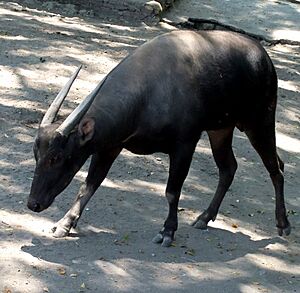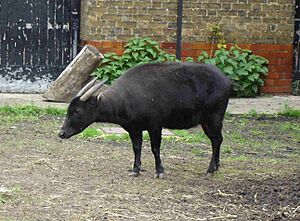Lowland anoa facts for kids
Quick facts for kids Lowland anoa |
|
|---|---|
 |
|
| Lowland anoa (B. depressicornis) at the Surabaya Zoo, Surabaya, East Java, Indonesia | |
| Conservation status | |
| Scientific classification | |
| Genus: |
Bubalus
|
| Species: |
depressicornis
|
| Synonyms | |
|
Anoa depressicornis |
|
The lowland anoa (Bubalus depressicornis) is a type of buffalo that lives only on the island of Sulawesi in Indonesia. It's a close relative of the mountain anoa, and scientists are still discussing if they are truly different species. Both are also related to the larger water buffalo.
Contents
Are Anoa Different Species?
Scientists have found it hard to tell the difference between the lowland anoa and the mountain anoa just by looking at their skulls. There might even be some mixing between the two types in zoos. People have wondered if they are truly separate species because they live in the same areas. Also, they sometimes breed with each other.
However, a study looked at the DNA of ten anoa from different places. It found that there were big genetic differences between individuals. This suggests that the lowland and mountain anoa are indeed two separate species.
Ancient Anoa Relatives
An extinct animal called Bubalus grovesi used to live in southern Sulawesi. It seems to be a close relative of both the lowland and mountain anoa.
What Does a Lowland Anoa Look Like?
The lowland anoa is a small type of bovid, which is a group of animals that includes cattle. It's only a little bigger than the mountain anoa. It stands just over 90 centimeters (about 35 inches) tall at the shoulder. It weighs between 150 and 300 kilograms (about 330 to 660 pounds).
Lowland anoa usually live alone or in pairs. They prefer lowland forests, where they eat plants and small trees. They are different from most cattle, which live in large groups.
How to Spot a Lowland Anoa
Experts can tell the lowland anoa apart from the mountain anoa in a few ways. The lowland anoa is generally larger. Its horns have a triangular shape when you look at them from the side. It has thin hair, not thick and woolly hair. Also, it almost always has white markings on its face and legs.
Where Do Lowland Anoa Live?
Both types of anoa are found on the island of Sulawesi. They also live on the nearby island of Buton in Indonesia. They prefer to live in untouched rainforest areas. They usually live alone or in pairs, except when a mother anoa is about to have a baby.
Lowland Anoa Life Cycle
Not much is known about the life of anoa in the wild. However, anoa living in zoos can live for 20 to 30 years. They become old enough to have babies when they are two to three years old. Female anoa usually have one calf (baby anoa) each year. It's very rare for them to have more than one calf at a time.
Why Are Lowland Anoa Endangered?
Both types of anoa have been listed as endangered since the 1960s. Their numbers continue to drop, with fewer than 5,000 of each species likely remaining.
Threats to Anoa Populations
There are two main reasons why anoa numbers are decreasing:
- Hunting: Local people hunt anoa for their hides (skin), horns, and meat. This is currently the biggest problem in most areas.
- Habitat Loss: Anoa are losing their homes because human settlements are growing.
Logging is also a big problem. Anoa prefer to live deep inside forests, far away from people. When forests are cut down, their homes become broken up into smaller pieces. This means there are fewer places for anoa to live and breed. This breaking up of habitats can also stop different groups of anoa from mixing. Over time, this could lead to less genetic diversity and further decline.



